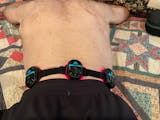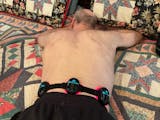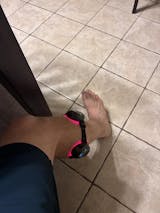Knee replacement surgery is a significant procedure that can provide long-lasting relief for individuals suffering from severe knee pain. However, the recovery process can be a challenge, and it varies for each person. While the road to recovery may seem daunting, understanding the typical recovery timeline and the steps you can take to improve it can make a big difference. In this article, we’ll explore the recovery journey after knee replacement surgery and how
medical-grade red light therapy devices can help speed up your healing process.
Understanding the Knee Replacement Recovery Process
Initial Recovery and Hospital Stay
After your surgery, you will likely stay in the hospital for a few days. During this time, your medical team will monitor your condition and begin light physical therapy to get your knee moving. It’s important to rest and take pain medications as prescribed during these initial days. This period sets the foundation for the rest of your recovery.
Pain Management and Medication
Pain management is a big part of your early recovery. You will be prescribed medications to manage pain, along with cold therapy to reduce swelling. It’s essential to follow your doctor’s guidance for medications, as managing pain effectively will help you begin walking and moving sooner. This is a crucial step for a successful recovery.
The Role of Physical Therapy
Physical therapy typically begins within a day or two after surgery. At first, exercises will be gentle, aiming to restore mobility and prevent stiffness. Following your physical therapist's instructions closely is key to improving your range of motion and strength. These exercises may feel challenging, but they are critical for your recovery.
How Long Does the Initial Recovery Take
Early Mobility and Walking
In the first two weeks, you will start walking with assistance, usually with the help of crutches or a walker. The goal is to gradually begin weight-bearing activity. By the end of this period, many patients are able to walk short distances and move around with less assistance. The key is to listen to your body and not overdo it.
Managing Swelling and Bruising
Swelling and bruising are common after knee surgery. You can manage these symptoms by elevating your leg and using ice packs as recommended by your healthcare provider. Swelling should decrease over the first few weeks, but it’s important to follow your doctor’s instructions to avoid complications and promote faster healing.
Use of Crutches or a Walker
For the first month or so, you’ll likely need crutches or a walker to assist with mobility. These tools help reduce the strain on your healing knee and ensure that you can move safely. As your knee heals and your strength improves, you’ll gradually use less support, but this can take time.
What to Expect After the First Month of Recovery
Increase in Mobility and Physical Therapy
After one month, you’ll likely see significant improvements in mobility. You can expect more freedom to move around without assistance. At this stage, your physical therapy will become more focused on strengthening your knee and restoring flexibility. Regular participation in these sessions is crucial to improving your function.
Pain and Discomfort Levels
By this point, pain should be much more manageable, although some discomfort is normal. Most people can reduce or stop taking pain medications. Light soreness when moving or exercising is common but should decrease as your knee becomes stronger. If pain persists or worsens, consult with your doctor.
Returning to Light Activities
Many people find that they can return to light daily activities such as walking short distances, driving, and even doing light housework by 4-6 weeks. While you’re still in the recovery phase, these activities are an important part of getting back to a normal routine and maintaining your physical health.
The Full Recovery Timeline
Strengthening Exercises and Continued Therapy
Between 6 to 12 weeks, you’ll begin more advanced strengthening exercises that will help rebuild muscle strength and improve your knee’s stability. The physical therapy will gradually become more intense, focusing on functional movements and more dynamic exercises. You should continue this as recommended by your therapist for the best results.
The Role of Medical-Grade Red Light Therapy Devices
Incorporating
medical-grade red light therapy devices into your recovery plan can significantly aid in healing. These devices work by reducing inflammation, enhancing circulation, and speeding up tissue repair. Using
FDA approved red light therapy on your knee can promote quicker recovery and lessen pain, allowing you to regain full function faster.
Milestones at Three to Six Months
By 3-6 months, most patients have regained most of their knee’s range of motion and strength. You will likely be able to return to most normal activities, such as walking, biking, and swimming. However, more strenuous exercises, such as running or jumping, should be approached carefully and only after clearance from your doctor.
Factors That Affect Recovery Time
Age and Overall Health
Your age and overall health play a large role in how quickly you recover from knee replacement surgery. Younger patients and those in better physical condition tend to recover more quickly than older individuals or those with chronic health issues. Maintaining a healthy weight and regular exercise routine before surgery can help improve recovery time.
Type of Knee Replacement Surgery
The type of knee replacement surgery you undergo also affects the recovery process. For example, a partial knee replacement may result in a shorter recovery time compared to a full knee replacement. Your surgeon will guide you through what to expect based on the specific type of surgery you have.
Adherence to Post-Surgery Guidelines
Following your surgeon’s post-operative care guidelines is essential to recovery. This includes taking medications as prescribed, attending physical therapy sessions, and using mobility aids as needed. The more closely you follow these instructions, the faster you will heal.
Pain Management During the Recovery Process
Pain Medications and Alternatives
While pain medications are common early on, it’s important to manage your pain in the least invasive way possible. You might be advised to use ice, heat packs, or other alternatives to reduce discomfort. Consistently applying cold therapy to your knee can help reduce swelling and ease pain.
Use of Heat Therapy and Cold Compresses
Alternating between heat and cold therapies can help relieve pain during different stages of recovery. Cold compresses are typically used in the first few weeks to reduce swelling, while heat therapy can help with muscle stiffness later in the recovery process.
The Long-Term Outlook for Pain
Pain levels should decrease significantly within the first few months, but mild discomfort when engaging in physical activities is normal. By the 6-month mark, most people report minimal pain or stiffness. Persistent pain should be discussed with your doctor to ensure proper healing.
Optimizing Recovery with Medical-Grade Red Light Therapy Devices
Benefits of Red Light Therapy for Joint Recovery
Using
fda approved red light therapy devices for pain can offer numerous benefits for your knee rehabilitation. Consider the
PRUNGO FluxGo. Studies have shown that these devices promote cell repair, reduce inflammation, and stimulate blood circulation—all of which help accelerate healing. Regular use of red light therapy can shorten recovery time and improve mobility.
How to Use Medical-Grade Red Light Therapy Devices
To get the best results, use red light therapy devices as directed by your doctor. Typically, the therapy is done in sessions, with the light applied directly to the knee for a specific amount of time. Be sure to follow your provider's guidelines for usage to ensure optimal results.
Clinical Research on Red Light Therapy
Mounting clinical evidence demonstrates the significant benefits of red light therapy for postoperative rehabilitation. Studies have found that continuous use of red light therapy can accelerate the rehabilitation process and significantly shorten recovery time. Therefore, red light therapy has become an important adjunct to knee replacement surgery rehabilitation, helping patients recover faster.
Conclusion
The rehabilitation process after knee replacement surgery can be challenging, but with proper care and guidance, you can recover smoothly. Everyone's recovery process is different, but using
red light therapy machine can significantly improve the outcome. Incorporating red light therapy into your rehabilitation plan can effectively relieve pain, accelerate healing, and improve joint function. If you require extensive treatment, a
red light therapy panel is ideal; for facial care, a
red light therapy mask can target multiple facial areas, making it particularly suitable for anti-aging, soothing, and repairing. Furthermore, it can improve skin health, reduce fine lines, even out skin tone, and effectively alleviate acne problems.




















Share:
What Is the Fastest Way to Relieve Knee Pain
How to Strengthen Lower Back